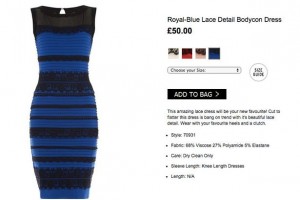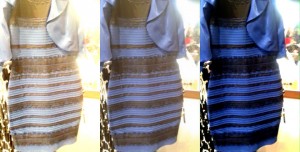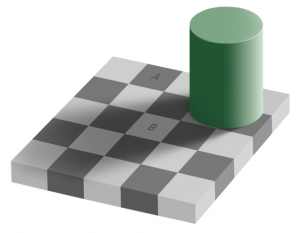Unless you’ve been living under a rock, or in Alaska for the past few days [insert a better pun], you might have come across this picture that’s been spreading faster than wildfire in the internet on your social media news feed.
Pretty simple image right?
Ok. So then let me ask you a question. What colour is this dress? Is it
- Black and Blue
- White and Gold
- Light blue and Orange
At a glance most of you would have shouted out WHITE AND GOLD!! Or maybe you agreed that there seems to be some shade of blue in the picture and guessed Black and Blue
Well as usual science has an answer! The dress is actually ….*drumroll please*……
BLACK AND BLUE!
Evidence: Well here is an actual advertisement of the dress
I know. I was shocked at first too.
(Small hint: tilt your screen back a little or cover the top half and voilà ! you will see the black and blue)
Well this is how it works. It’s all related to the main organ of perception in our body, our brain. But first let’s understand how we observe an object.
Light falls on an object and bounces towards us. That light enters the eye through our eye lens. Each colour having their corresponding wavelengths (397-723 nm for visible light). This light stimulates the rod and cone cells of the retina and a message is sent to the visual cortex of the brain to produce the sensation of vision. To make things easy for us our brain identifies the wavelengths of the light source and removes it from the source, so that we see the ‘Real’ colour.
As for the two main answers of Blue/Black and White/Gold, Bevil Conway, a neuro scientist who studies colour and vision at Wellesley College explains like this
Human beings evolved to see in daylight, but daylight changes color. That chromatic axis varies from the pinkish red of dawn, up through the blue-white of noontime, and then back down to reddish twilight.
“What’s happening here is your visual system is looking at this thing, and you’re trying to discount the chromatic bias of the daylight axis,”
“So people either discount the blue side, in which case they end up seeing white and gold, or discount the gold side, in which case they end up with blue and black.”
So basically we can narrow down this
From left to right; how your brain perceives the image, the source image and last, how the image should look with correct white balance adjustments
Still don’t believe me? Well try this then
In this chess board A and B are of the same colour. (Tilt your laptop screen back again)
We see them differently because
- Our brain expects the black and white pattern of the chess board to continue
- Our brain takes into account the shadow cast by the cylinder and assumes that B is white
If you saw two different colours for A and B, don’t worry, it means that your brain is functioning the way it’s supposed to J
I guess we can all agree that the human brain is truly an amazing piece of biological evolution!
References: http://www.wired.com/2015/02/science-one-agrees-color-dress/
http://io9.com/the-what-color-is-this-goddamn-dress-debate-explaine-1688378120





